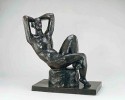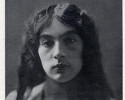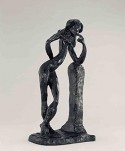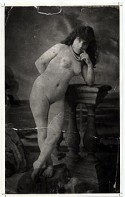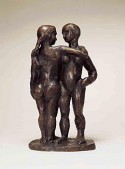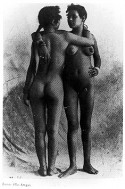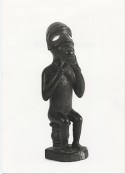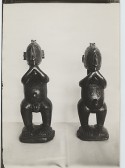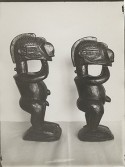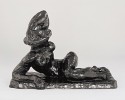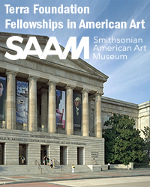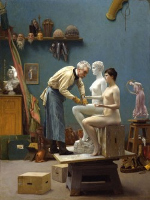The browser will either open the file, download it, or display a dialog.
|
Matisse: Painter as Sculptor |
|||||||||||||||||||||||||
|
Of all the assumptions surrounding the life and work of Henri Matisse, perhaps the most persistent is that little is left to discover about this canonical modernist. The grip of this idea gave way in Matisse: Painter as Sculptor, a major traveling exhibition co-curated by Dorothy Kosinski, formerly of the Dallas Museum of Art; Jay McKean Fisher of the Baltimore Museum of Art; and Steven Nash, formerly of the Nasher Sculpture Center in Dallas. Featuring over half of Matisse’s approximately 80 sculptures, alongside his related paintings and drawings (some rarely or never before exhibited) and comparative works by other artists such as Rodin, Cézanne, Maillol, Bourdelle and Picasso, the exhibition made a convincing case for revisiting the undeservedly marginal status of Matisse’s sculpted oeuvre. |
||||||||||||||||||||||||||
|
Despite the curators’ stated goal of encouraging visitors to “see these sculptures as the complement to Matisse’s paintings,” their elegant installation at the Baltimore Museum gave the small, sometimes tough, works the breathing room they require, at a remove from the space-swallowing color of his paintings. Those paintings have largely dictated the ways we look (and don’t look) at his sculpture. Matisse himself modestly described sculpture as a “rest from painting,” but this exhibition underlined the very material role sculpture played in shaping the seemingly contradictory traditions and ideas that came to define the artist’s modernity.1 Moreover, the three-dimensional work—overwhelmingly devoted to the nude—helps bring a transcendent Matisse down to earth. It dispels the old notion that Matisse used the body as a neutral armature for experiments in form, revealing him instead to be deeply engaged with the body’s content, particularly its sexuality. |
||||||||||||||||||||||||||
|
The first two galleries highlighted the complexity of Matisse’s early responses to the recent past of French sculpture. His response to tradition had many facets: it was neither all-out rejection, nor—as some have argued is characteristic of Matisse’s work in general—conservative continuation beneath an avant-garde gloss. One of his earliest sculptures, Jaguar Devouring a Hare (1899-1901), was begun in an evening sculpture class, where Matisse was assigned to copy a cast from the Louvre. He chose a piece by Antoine-Louis Barye, the “Michelangelo of the menagerie,” and over a period of two years reconceived the earlier sculptor’s meticulous depiction of violent animal instinct, subverting the pedagogical purpose of the academic copy. Matisse’s Jaguar Devouring a Hare, exhibited in Baltimore side by side with Barye’s bronze of the same title (1850), is, in many ways, amazingly faithful. Matisse re-creates details like the triangle of taut skin under the extended front leg of Barye’s beast. But in the Matisse, the distinctive treatment of skin as an envelope for muscle evaporates. Barye’s wedge of flesh becomes inert material, for example, as Matisse shifts the expressive energy of the sculpture away from such details onto an overall rhythmic arabesque uniting otherwise static masses. |
||||||||||||||||||||||||||
|
While still working on Barye, he next took on Rodin. Matisse met the celebrated master in 1900 and the same year hired the Italian model Bevilacqua, who had earlier posed for Rodin’s John the Baptist and Walking Man. Several well-chosen drawings reveal Matisse absorbing the peculiarities of his aging model’s anti-heroic physique, in echoes of Rodin’s working process for Balzac. The drawings, each done as if by a different hand, give some sense of the evolution that took place over the three long years Matisse spent modeling The Serf (1900-03). In Baltimore, the pairing of this burly sculpture with Matisse’s related Cézannean painting of Bevilacqua announced a theme to be developed in Matisse’s later sculptures: that of the body as an open field of tactile sensations loosened from the hierarchy of actual human anatomy. |
||||||||||||||||||||||||||
|
|
The Serf was also installed alongside Rodin’s Jean d’Aire from the Burghers of Calais (1895), allowing the curators to stress the ways that Matisse’s approach, still emerging, differed from Rodin’s (fig 1). One could begin and end simply by comparing the relationship of the figures’ feet with their respective grounds. In the Rodin, the toes grip the edge of the base, grounding Jean d’Aire to the soil of Calais. By contrast, Matisse barely articulates the passage from the base to the two trunk-like legs forming the triangular anchor of the figure’s lower half. (The base is engraved with “Le Serf” as if to remind us that it is indeed just a base.) If the curators had selected another kind of Rodin, however—such as his Walking Man—we would have seen that Matisse’s response to the sculptor was, in fact, multidimensional. Matisse criticized Rodin for fragmentation, but he also admired the awkward traces of labor that Rodin deliberately left visible. The swelling extrusion on the right shoulder blade of The Serf could be read as the inverse of the huge gash left in the small of Walking Man’s back. |
|||||||||||||||||||||||||
|
|
Over the course of his career, other artists and traditions similarly served as a plumb line against which Matisse could measure his sculpture. In a later episode, Matisse reconceived Michelangelo’s tomb figure, Night, as a Large Seated Nude (1922-29), featuring a range of surprisingly different views and impressions of the body (fig. 2). Not all of his ideas came to him in extended dialogue with canonical art, however. At least eight of Matisse’s sculptures from his most productive years of modeling, 1906-09, can be definitively traced to a far more prosaic source: photographs of nude models in stock poses. He found them in revues such as Mes Modèles and L’Étude académique, titles in a burgeoning industry of erotica publications ostensibly aimed at artists who could not afford live models (fig. 3). The revues’ adoption of an “artistic” pose was an alibi to elude censors, allowing publishers to exploit the new, inexpensive halftone screen and mass-produce images of the nude as never before. But the pretext also created a strange shadow of École des Beaux-Arts tradition, providing Matisse with a novel means of negotiating his response to it, through a caricatured condensation in a 50-centime commercial product. |
|||||||||||||||||||||||||
|
The exhibition documented in wall texts two such photographic sources, and others are touched upon in catalogue essays by Nash and Fisher. Matisse scholars have been uncharacteristically cursory about this perplexing material, partly because it fails to conform to a long-standing image of the artist inspired by the presence of live models. According to Louis Aragon, Matisse needed to have his “eyes less than a meter away from the model and knees within reach of her knees.”2 With these photographs, however, Matisse was able to look sidelong at his models as he reformulated the erotic encounters in the photographers’ art-historically sycophantic scenarios. Borrowing from one such source for The Serpentine (1909), Matisse turned an ironic focus on one of the most mawkish detail—the model’s “contemplative” hand gesture, in which she presses one finger to her upper lip (figs. 4 and 5). As a result of the stretching and twisting that Matisse imposes on the model’s plump anatomy, her stubby pointer becomes an attenuated fulcrum around which the lines of this volumetric drawing in space circulate. Matisse seizes on the discrepancy between the artifice of the pose and the more dynamic, unruly experience of the body subjected to it. |
||||||||||||||||||||||||||
|
Moreover, in The Serpentine, as in many of Matisse’s nudes, what at first seems exaggeratedly feminine embraces much that is masculine. The phallic cap of the vertical support, which enhances the inhale-exhale of the figure’s unpredictably ballooning forms, also supplies the tumescence that the pliant body lacks. The Serpentine plays out sexual difference as a continuous loop of sensations, a material abstraction that helps to explain the early and bewildered responses to the work. When the American critic Henry McBride first saw The Serpentine in Matisse’s studio at Issy, for example, he remembered being “struck dumb” by this “Venus. . . the figure which at first seemed an ineffective joke.”3 |
||||||||||||||||||||||||||
|
The humor in Matisse’s send-up of idealized gender has lost its resonance over the years. This is Matisse the modernist, after all, and The Serpentine’s spatial dynamics, shifting unexpectedly from one view to the next, is serious business. But such multiplicity does not limit interpretations to questions of space and form. The sculpture’s impact also stems from its pointed rebuke to its source photograph’s promise of total bodily possession, in order to suggest a wider range of complex, if also contradictory, pleasures. |
||||||||||||||||||||||||||
|
|
In Baltimore, works were installed to draw parallels between the poses used by Matisse in his sculpture and paintings, and those used by other artists. But Matisse’s self-conscious recycling of shopworn École conventions means that this is not an entirely satisfying way to proceed. Focusing on pose alone encourages us to look for what is familiar about Matisse’s sculpture, when what the sculpture really demands is a sustained appraisal of how something misleadingly familiar can be entirely re-imagined. Near the beginning of the exhibition, the curators pitted the strenuously cantilevered Meditation (1885) by Rodin against two versions of Matisse’s more self-contained Madeleine (1901 and 1903) (fig. 6). Unlike Rodin, Matisse would not seek new bodily truths in an unusual gesture or configuration. As in the later Bonheur de Vivre painting, to which he would return again and again in his own sculptures, the poses he chose were so standard in the history of art as to be almost banal. |
|||||||||||||||||||||||||
|
Like Cézanne, who also borrowed many of his Bathers from commercial art reproductions, “images d’un sou” (penny images) as Ambroise Vollard described them, Matisse turned the encyclopedia of stock poses against itself, shifting the focus from illustrated sentiment and narrative to material qualities.4 The curators signaled Matisse’s debts to Cézanne by exhibiting the sculpture La Vie (1907) next to a painted académie by Cézanne, Standing Female Nude (1898-99). In emphasizing the late nineteenth-century French roots of Matisse’s sculpture, however, the curators neglected its African ones. Matisse began collecting African sculpture in late 1906, giving him access to an entirely different set of ideas about non-narrative figurative expression. This is especially evident in the compact (8 3/4 inches high) and commanding La Vie. |
||||||||||||||||||||||||||
|
|
This sculpture is a rework of the earlier Standing Nude: Arms on Head (1906-07), but with legs and arms removed. Complicating the sculptures’ cultural origins even further is the fact that both works were based on a photograph of a North African-identified model from the pseudo-ethnographic L’Humanité féminine, the same publication in which Matisse would later find his photographic source for Two Negresses (1907-08) (figs. 7, 8).5 For La Vie, Matisse transformed the flat, two-dimensional pattern of the photographed model’s body through the “invented planes and proportions” (his words) he admired in African art, although the sculpture’s anatomical distortions are only the most outwardly visible sign of African influence. The African sculptures Matisse knew (from the Vili, Fang and Baga cultures, for example) showed him ways to convey a more open-ended, haptic experience of human anatomy. Like the 9-3/8-inch Vili statue from Congo that was Matisse’s first acquisition, La Vie is explicitly conceived for the scale of the human hand (fig. 9). The removal of limbs from the earlier Standing Nude heightens the impression of the torso as a thing to be held. One can imagine fingers resting in the deep grooves of the armpits, expressly made for and by them. |
|||||||||||||||||||||||||
|
Yet despite the intimacy afforded by diminutive scale, the general tone of La Vie is not one of whispered confidences. Its outwardly directed forms emphatically assert themselves, conveying a sense of monumentality from a distance—which, as Matisse specified to his students, was one of the primary challenges of the medium.6 Sexuality is not coyly disclosed as the private property of an individual subject, but vigorously released as a collective force. Matisse was drawn to African sculpture not just because he thought of Africa as the mythic source of erotically charged creative energy, but because the visual nuances of its many different sculptural traditions dealt with sexuality in more richly imaginative terms. |
||||||||||||||||||||||||||
|
In a pair of Baga D’mba figures from Guinea that Matisse owned, for example, the distinction between the female figure and its male partner seem fairly straightforward (fig. 10).7 Yet through a series of shared forms, male and female can also be conceived as interpenetrating realms. Volumes harmoniously echo one another in a misleading symmetry. Visual signs of gender difference—height, breasts, penis, navel—are read across the two figures in tandem, and secured in relation to each other. In a photograph of the D’mba sculpture in profile view, for example, the figure on the right is only read as female because her male partner is present (fig. 11). |
||||||||||||||||||||||||||
|
This idea of positing the body as a site of relations, rather than as a closed and irreducible identity, is as much a part of the African influence on Two Negresses as Matisse’s often noted stylistic appropriations (fig. 7). From one angle of Matisse’s sculpture, the two figures appear to be complementary front-and-back views of a female physique. From another, the slighter taller figure seems mannish, with an enormous pair of ballooning feet, thinly muscular buttocks, and a shorn, rounded head. The masculinity of this gender-shifter is contingent, however, not only on our angle of viewing, but also on its relative difference from the female figure to which it is attached. Hand on hip, legs spread apart, the figure’s carriage reads as masculine when seen against the demure, knees-together stance of its partner. Depending on where we stand and how we look, one figure could be either male or female, and the couple could be either lesbian or heterosexual. Instead of a complete, all-knowing view, we have an irresolvable play between positions of sexed identity and a multiplication of the erotic relations that can arise as a result. |
||||||||||||||||||||||||||
|
La Vie and Two Negresses are just two of several sculptures vividly revealing how Matisse worked both with and against African esthetics. Nash and other authors frequently cite the “discordant lessons” of African art in the catalogue, but in the galleries, African art made no appearance. Sustained discussions of African influence have likewise not been evident in recent literature on Matisse; the key studies by Jean Laude and Jack Flam are now over twenty years old.8 Matisse’s evolving relationship to African sculpture was subtle and multifaceted; the reasons we have not heard more about it are equally complex. As with other long-standing misperceptions about the artist, Matisse himself is partly to blame. Once he and other members of his avant-garde circle began witnessing the transformation of African art into a fashionable commodity, they disavowed it as a source for their own art. Matisse spoke out in 1919 against the self-conscious intellectualism of primitivism in the Catalan journal Vell i nou.9 In 1920, Picasso famously denied knowing African art at all. |
||||||||||||||||||||||||||
|
In addition, apart from the well-published Vili figure, we do not yet know enough about the other African sculptures Matisse collected beginning in late 1906. There are a few pieces in the Musée Matisse in Nice, but the rest are in private hands. Even if these objects had been available for loan, however, we might still not have seen them. The legacy of MoMA’s controversial “Primitivism in Twentieth Century Art” exhibition in 1984, roundly criticized for an ethnocentric focus on formal affinities between the tribal and the modern, seems to have effectively made such object-based approaches permanently suspect. But we will certainly never approach a richer, more discursive understanding of this primal episode of modernism—urgently called for in the critical challenges to MoMA’s exhibition—if we continue to ambivalently conjure, but never really see, the objects at the very center of the encounter.10 |
||||||||||||||||||||||||||
|
|
With Matisse’s sculpture, it is also easier, and just as well reasoned, to emphasize his allegiance to the terra firma of Greco-Roman classicism. Even the Africanized La Vie inevitably recalls the truncated forms of classical torsos (and Matisse, we know, collected these as well). In his most compelling sculptures, such as Reclining Nude I (Aurora), (1907), Matisse did not so much smoothly synthesize these incongruous sculptural traditions as yoke them together (fig. 12). This is a very different strategy from that adopted by other early twentieth century sculptors, who sought to uncover the primitive roots suppressed within the classical. Such an approach was represented here by a well-chosen work by Bourdelle, the Large Bacchante (1907), an ecstatic, grape-laden dancer mounted on a gnarled pedestal of wood. |
|||||||||||||||||||||||||
|
Matisse’s hybrid primitivism was about harnessing seemingly irreconcilable forces—thus the restless, unresolved energy of Reclining Nude I. Here, the Greco-Roman Sleeping Ariadne, a voluptuous recliner, is reconfigured with the elemental, tightly interlocking volumes of African sculpture. Passages with differently gendered associations are also brought in close proximity: the sphere of the right breast is doubled by the brawny shoulder just above; the soft tubular roll of the abdomen parallels the explosive muscularity of the nearby thigh; and a relatively dainty neck meets a raised arm whose bicep is at least twice its mass. Reclining Nude I is not just about female seduction weighed down or disfigured by virility; this is a body straining against expectations that difference can be clearly delimited. |
||||||||||||||||||||||||||
|
Although scholars have increasingly turned their attention to the question of sexual difference in Matisse’s painting, it has yet to be explored in Matisse’s sculpture.11 Almost all of his sculptures take the female body as their subject, but many of those sculptures do not represent that subject as the safely distant object of male heterosexual desire. Instead, they co-opt the physical effects of desire, making manifest its open-ended and circuitous routes. |
||||||||||||||||||||||||||
|
|
As might be expected from one of the sharpest observers of Matisse’s work, Picasso recognized this giving form to desire as a theme in Matisse’s later “Jeannettes,” his series of five heads that grow increasingly abstract over time (1910-16). From Jeannette IV (1913) to Jeannette V (1916), Matisse modified his composition by pulling the caricatural volume signaling hair into the structure of the skull itself (fig. 13). Now continuous with an exaggerated nose, the female hair is fetishistically displaced onto phallic form. After seeing the “Jeannette” sculptures at a 1930 exhibition, Picasso embarked on a series of portrait heads of Marie-Thérèse Walter with more explicitly sexualized volumes, responding as if to unmask “Jeannette.”12 In Baltimore, where Picasso’s Head (1931) faced off against Matisse’s “Jeannette” series, Picasso seemed like the guest at a party who repeats the joke or story to a more receptive audience, now ready to hear it. Our image of modernism holds that Picasso was witty, sardonic, erotically charged—while Matisse was not. |
|||||||||||||||||||||||||
|
Long before, in his Cubist constructions, Picasso had opened three-dimensional form to the active interrogation of space, setting forth the major material and conceptual preoccupations that would occupy future generations of sculptors. That Matisse continued to model figures in clay would seem to suggest that he was out of step with the dominant discourses of twentieth-century sculpture. Yet his work remains stunningly fresh and relevant today because it reformulates the human figure in ways that also express the complicated nature of desire for it. Matisse’s sculpture represents not so much a “rest from painting” as an opportunity for us to retire some of our misplaced certainties about the larger themes of his work, both sculpted and painted. |
||||||||||||||||||||||||||
|
Ellen McBreen |
||||||||||||||||||||||||||
|
1. Matisse’s remark was recorded in an interview with Pierre Courthion. For this, and other translated comments on Matisse’s sculpture, see Claude Duthuit and Wanda de Guébriant, eds. Henri Matisse: Catalogue raisonné de l’oeuvre sculpté. (Paris: Claude Duthuit Éditeur, 1997): 381-387. 2. Yves-Alain Bois cites the Aragon in his discussion of Matisse’s need for the “full presence of the object or motif, a materiality that prompts his initial impulse to paint or draw.” Bois, Matisse and Picasso (Paris: Flammarion, 1998): 25. The original source is Aragon, Henri Matisse: A Novel, Volume I (1972): 104. Clearly, Matisse’s use of photographs opens this image of the artist to some reconsideration. Both Nash and Fisher briefly outline issues related to the photographs in their catalog essays, referring to past discussions by both Isabelle Monod-Fontaine and Katharina Sykora. Steven Nash, “The Other Matisse,” and Jay McKean Fisher, “Drawing is Sculpture Is Drawing,” in Matisse: Painter as Sculptor (Baltimore, Baltimore Museum of Art, Dallas, Nasher Sculpture Center and Dallas Museum of Art, and New Haven, Yale University Press, 2007). 3. McBride recounted this visit in his Matisse (New York: Knopf, 1930). Cited by Alfred Barr, Matisse: His Art And His Public (New York: Museum of Modern Art, 1951): 139-140. 4. Ambroise Vollard, Souvenirs d’un marchand tableaux (1937), second edition (Paris: A. Michel, 1938): 209. Cited by Jean-Claude Lebensztejn, “Une Source Oubliée de Cézanne,” in Études cézanniennes (Paris: Flammarion, 2006): 54. 5. I discuss this newly proposed photographic source in my The Pinup and the Primitive: Eros and Africa in the Sculpture of Henri Matisse (1906-1909). (Ph.D. dissertation: Institute of Fine Arts, New York University, 2007). 6. “Drawing is like an expressive gesture, but it has the advantage of permanency. A drawing is a sculpture, but it has the advantage that it can be viewed closely enough for one to detect suggestions of form that must be much more definitely expressed in a sculpture which must carry from a distance.” From “Matisse Speaks to his Students, 1908: Notes by Sarah Stein.” Reprinted in Barr (1951): 551. 7. According to Sarah Stein’s 1908 notes, recording remarks made by Matisse in the early days of his Academy, he counseled his students: “the joint is better when exaggerated than when under expressed. Above all, one must be careful not to cut the limb at the joints, but to have the joints as inherent part of the limb. The neck must be heavy enough to support the head (in the case of a Negro statue where the head was large and the neck slender the chin was resting upon the hands, which give additional support to the head).” Sarah Stein’s notes are cited in Barr (1951): 551. I believe the “Negro statue” described here in Stein’s notes may very likely be one of the two D’mba figures from Guinea, because of the relative thinness of the neck. For this reason, we may be able to secure a 1908 acquisition to the pair. However, since the object described in Stein’s notes could also plausibly be the Vili figure, it is difficult to say with certainty. The photographs of these D’mba sculptures are from the Matisse Archives in Paris. They also appear in a photograph alongside other objects in Matisse’s collection, in the Hôtel Régina, Nice, reproduced in 'Primitivism' (1984): 237. 8. Jean Laude, La Peinture Francaise (1905-1914) et l’art nègre (Paris: Éditions Klincksieck, 1968). Jack Flam, “Matisse and the Fauves,” in “Primitivism” in 20th-Century Art: Affinity of the Tribal and the Modern, exh. cat. (New York: Museum of Modern Art, 1984): 211-239. 9. J. Sacs, “Enric Matisse,” Vell i nou (November 1, 1919). Jack Flam, Matisse on Art, Revised Edition (Berkeley: University of California Press, 1995): 56-60. For Picasso's infamous response to Fels—“Negro art? Never heard of it!”—published in the journal Action in 1920, see Flam and Miriam Deutch, eds., Primitivism and Twentieth-Century Art: A Documentary History (Berkeley: University of California Press, 2003): 131. 10. The critical challenges to which I refer include James Clifford, The Predicament of Culture: Twentieth-Century Ethnography, Literature, and Art (Cambridge: Harvard University Press, 1988); Hal Foster, "The “Primitive Unconscious of Modern Art" October 34 (Fall 1985): 45-70; Thomas McEvilley, “Doctor, Lawyer, Indian Chief,” Artforum 23 (November 1984): 54-60. 11. See, for example, Margaret Werth’s chapter on Matisse in her The Joy of Life: The Idyllic in French Art, circa 1900 (Berkeley: University of California Press, 2002), and John Elderfield, Pleasuring Painting: Matisse’s Feminine Representations (New York: Thames and Hudson, 1995). 12. Bois, Matisse and Picasso, exh cat. (Paris: Flammarion, 1998): 67. |



